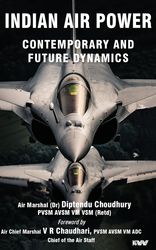On February 21, Turkey successfully conducted the maiden flight of its fifth generation fighter jet KAAN, becoming one of the few countries in the world to master the cutting edge technology. India's fifth generation fighter, the Advanced Medium Combat Aircraft, remains a work in progress. In the history of aerial warfare, Turkey was the first victim, notes Air Marshal Diptendu Choudhury (retd) in his book, Indian Air Power: Contemporary and Future Dynamics.
On October 22, 1911, Italian pilots used aircraft to bomb a Turkish army camp at Ain Zara (in present day Libya) during the Italo-Turkish war. The audacious move by the Italians threw open endless possibilities and soon “command and control of the air” became the “key outcome and the dominant narrative” for air power thinkers and strategic experts. Just about two decades after the first air attack, in October 1932, the Indian Air Force was launched formally.
In Indian Air Power, Air Marshal Choudhury attempts a comprehensive overview of the evolution of the Indian Air Force. In 14 chapters, the book explains how the IAF transformed itself into one of the key guarantors of national security. The book is a timely addition to the scholarship on national security, especially with the unprecedented rise of China as a global power, rivalling the United States.
Beijing's aggression in the South China Sea and in north Ladakh and its deepening partnership with Pakistan “serve as a reality check that the days of peace and tranquility on the borders are over”, says Air Marshal Choudhury. He warns that the IAF's combat squadrons dropping below the required critical mass has become a major national security problem that should be addressed at the earliest. Time has come, he says, to take into account the enduring structural aspects of air power and consider doctrinal and paradigm changes that are relevant for the future.
Apart from conventional warfare, India's strategic leadership also needs to consider future vectors of aerospace power as it increasingly becomes a vital cog in the national security calculus. Space technology is the next frontier and Air Marshal Choudhury observes that while the US remains the world leader in this domain, China's confident strides in the field are likely to lead to the militarisation of the global commons. He says India needs to integrate space into a war-fighting domain in national security without any further delay.
Air Marshal Sir John Steele, India's Air Officer Commanding in Chief from 1931 to 1935, was initially dismissive of the ability of Indians to run the Air Force. “Indians will not be able to fly and maintain military aeroplanes. It's a man's job,” he said. Air Marshal Choudhury says it was the “sheer grit of the intrepid Indian airmen that not only proved Steele wrong, but earned the enduring respect and admiration of sceptics”.
The IAF's doctrinal and strategic evolution has been a critical element in the Indian defence ecosystem and the book suggests that more needs to be done to prepare it for future endeavours.
INDIAN AIR POWER: CONTEMPORARY AND FUTURE DYNAMICS
Author: Air Marshal (Dr) Diptendu Choudhury (retd)
Publisher: KW Publishers
Price: Rs1,480; pages: 244


